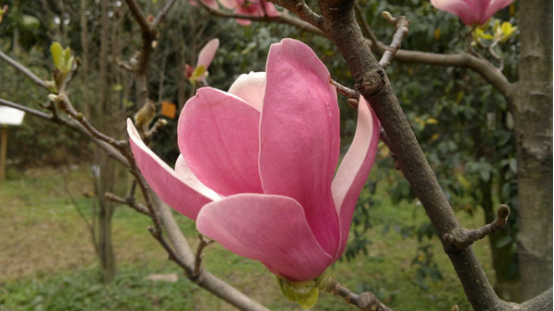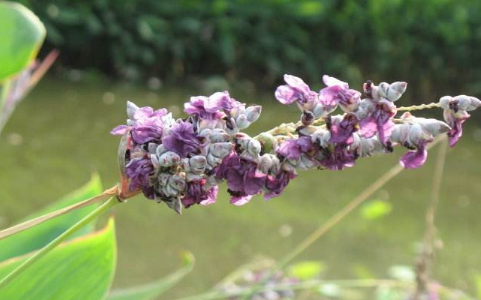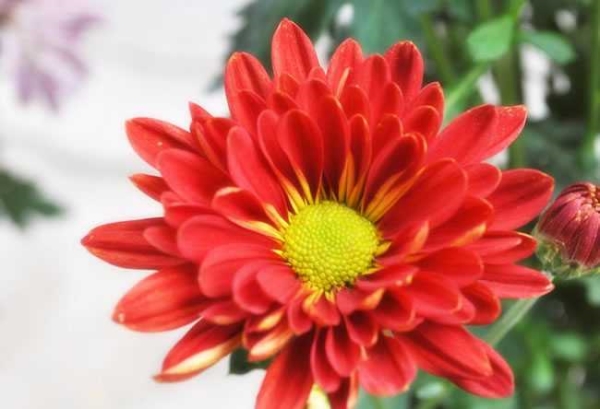four。 Matters needing attention in the maintenance of magnolia flowers:
Magnolia love light, compared with other flowers and trees, Magnolia is cold-resistant, but we pay attention to Magnolia is not resistant to drought, we should pay attention to keep the soil moist. Usually to ensure water supply, often spray water to the leaves, increase air humidity, so as to avoid yellow leaves and fallen leaves. The soil is required to be fertile to ensure the supply of nutrients. Magnolia like fertilizer, there is a good permeability of the soil to dig holes in winter, apply organic fertilizer, such as bone meal, cake fertilizer.

At this point, the editor's introduction of magnolia is over. I hope netizens can know more about magnolia. Thank you for your support to the four Seasons Plant Network!
How to raise Magnolia, 6 maintenance methods and matters
Magnolia blossoms, the ornamental is very high, then how to raise magnolia, first of all to know the growth requirements of magnolia, the following are summarized magnolia culture methods and matters.
How to raise Magnolia 1. Soil requirements
Magnolia is like fertile, moist, and well-drained sandy soil, Magnolia is not drought-resistant, avoid alkali, so it grows poorly on dry, alkaline soil and clay.
2. Lighting requirements
Magnolia like sufficient light, slightly shade-resistant, generally in peacetime maintenance, need to pay attention to light, maintenance environment, so that magnolia can fully accept the sun as far as possible.
3. Watering requirements
To know that magnolia is to avoid drought and waterlogging, usually watering, as long as to ensure an adequate supply of water, it is recommended to often spray water to the leaves of magnolia, increase the dampness of the air, so as to avoid yellow leaves.
4. Fertilization requirements
Magnolia is a fertilizer-loving flower plant, which needs timely fertilization to supplement nutrition in peacetime maintenance. Magnolia is generally fertilized once before and after flowering, mainly with phosphorus and potassium fertilizer, and the mature barnyard manure is applied as base manure from October to November every year, during the period of sprouting and branching after flowering. Apply available nitrogen fertilizer for 2 or 3 times.
5. Temperature control
Magnolia likes a warm and humid climate and can withstand cold, but if the temperature is low in winter, it is recommended that magnolia be moved indoors to keep warm for breeding to avoid frostbite.
6. Pruning requirements
Generally speaking, in order to form a tree-shaped magnolia, it is necessary to remove tillers, sprout and prune, so that the pruning is mainly to facilitate the tree-shaped growth of magnolia.
Culture methods and matters needing attention of Magnolia Magnolia
Magnoliaceae
Magnolia
Scientific name Magnolia liliflora Desr.
Alias Mulan, Magnolia, Magnolia, Wood Pen
English name mangnolia
Small deciduous trees, up to 5 meters high. The wood is fragrant, the branchlets are purple-brown, and the buds have fine hairs. Leaves simple, alternate, Obovate-elliptic; with stipules scars. Flowers bisexual, solitary, terminal, sepals 3, yellowish green, lanceolate, ca. 3 as long as petals; petals 6, purplish red outside, inner surface subwhite; pistil numerous, pistil sessile. The fruit is round in shape. Root is fleshy.
1. Morphological characteristics.
Magnolia trees can be up to 5 meters high, when the flowers are proud to stand on the branches, pure white and holy, because Magnolia flowers bloom first, and then grow leaves, so magnolia blossoms are full of white trees without miscellaneous colors, making people feel admired suddenly. Therefore, magnolia flower language is a noble soul.
On teacher's Day every year, it is popular for children to give their own gifts to teachers. Sending greeting cards is not environmentally friendly and not in line with the trend. Sending expensive gifts is not in line with the identity of children, so it is better to send an open magnolia. To express your respect and praise for the teacher's noble soul.
Bai Juyi, a poet of the Tang Dynasty, once wrote a poem praising magnolia. The poem said, "the purple room is torn down according to rouge, and the plain and beautiful wind is greasy with powder." It's so weird that Mulan used to be a girl. " Here, Mulan borrows the ancient legendary heroine Hua Mulan.
Small deciduous trees or shrubs, 1.5-3m tall or higher. Bark grayish brown; branchlets slender, sparsely slender hairy, twigs densely pubescent. Winter buds elliptic or oblong, covered with brown glossy short hairs. Simple leaves alternate; petiole 1-4 cm long; stipule scar 1 × 2 of petiole; leaf blade lanceolate-elliptic or Obovate-elliptic, 6-14cm long, 4-10cm wide, apex acute or shortly acuminate, base cuneate, dark green above, glabrous, gray-green below, glabrous except sparsely tomentose along leaf veins. Flowers and leaves bloom at the same time, solitary at the top of branches, fragrant, cup-shaped, about 6cm in diameter; perianth 9, fleshy, milky white or light pink to pink, oblanceolate or subspatulate; stamens numerous, about 1cm, filaments about 4mm, purplish red, anther septum apex yellow; pistil group oval. The pistil stalk is about 5mm. Style thin and curved. The pistil matures earlier than the stamen, the natural seed setting rate is low, and the tillering ability is strong. The shape characteristics of magnolia.
2. Species distribution
Magnolia is a kind of plant, which is native to mountain mixed forest and mountain forest in central China, and is mainly planted in Fujian, Jiangsu, Jiangxi, Zhejiang and Anhui provinces.
3. Cultivation techniques.
The method of striping and plant division was used to propagate. Sometimes sowing is also used. Ramet can be carried out in spring and autumn, the mother plant with dense branches can be dug out and planted separately, and the root system and short branches can be trimmed. Striping, selected from 2012 branches, can be propagated by piling soil or burying strips in early spring. Sow seeds, collect seeds in September, store sand in winter, sow in spring the following year, and germinate 20-30 days after sowing. Cultivation and management is simple, pay attention to drought and waterlogging prevention, timely fertilization. The transplant can be carried out before flowering in autumn or early spring, the seedlings are stained with mud, and the big seedlings must carry soil balls. Fertilization was applied once before and after flowering, mainly phosphorus and potassium fertilizer. Maintain soil moisture in high temperature in summer and dry in autumn. After flowering and before sprouting new branches, dry branches, dense branches and short long branches should be cut off.
Mulan likes light and is slightly resistant to shade. Like warm and humid climate, but also can withstand cold. Like fertile, moist and well-drained sandy soil, not resistant to drought, avoid alkali, and grow poorly on dry, alkaline soil and clay. The root is fleshy, afraid of flooding, the wound is getting worse, and transplanting is not easy to survive. Strong tillering. Magnolia is propagated by ramets, striping, cuttings, etc.
The transplanting of magnolia is carried out before blooming in spring or after defoliation in autumn, small seedlings need to stay in the soil, and large seedlings carry soil balls. Mulan likes fertilizer, and the mature barnyard manure is applied as base manure from October to November every year. During the sprouting and branching period after flowering, the available nitrogen fertilizer is applied for 2 or 3 times, and the rhizosphere is covered and watered properly in the dry season. Flowers and leaves are expected to flourish in the following year.
Magnolia must be sprouted and pruned if it is to become a tree. Magnolia root rot, red spider, drill beetle and so on should be controlled in time.
Maintenance like light, more cold-resistant, but not drought-resistant. It requires fertile sandy soil and is not resistant to alkali. I'm afraid of flooding. Magnolia like humid and semi-overcast climate, like fertilizer, have good permeability of soil to dig holes in winter, apply organic fertilizer, such as bone meal, cake fertilizer. Magnolia has strong cold tolerance, but avoid drought and waterlogging, usually to ensure water supply, often spray water to the leaves, increase air humidity, so as to avoid yellow leaves and fallen leaves.
The control of diseases and insect pests is mainly harmful to flowers and trees, the host is very wide, and the harm is widespread. Female adults and larvae often concentrate on buds, leaves, branches and stems to suck juice, and when serious, it can cover the whole branch, resulting in yellowing of leaves, short, deformed shoots, fallen leaves, withered branches, and even death of the whole plant, and it is easy to induce coal fouling, blacken the leaves, hinder photosynthesis and affect the tree potential, thus reducing the ornamental value. The first and second instar nymphs secrete a large amount of honeydew when sucking juice, which is the main cause of coal pollution disease. When the female adult is mature, it is often fixed and no longer transferred.
Prevention and control methods:
1. Forest management measures: remove the pest plants in the field and prune the branches with insects, and take them out of the field in time for burning.
2. Biological control: protect and introduce Australian ladybugs, big and small red ladybugs.
3. Drug control: Popper 1-3 degree stone sulfur mixture is sprayed during dormancy period; 40% omethoate EC 1000 times and 10% pyridine wettable powder 1500 times liquid can be used during nymph incubation period; when adults occur, they are evenly sprayed with 800 times of scale killing EC or 1500 times of 40% speed killing EC, and the permeability can be increased by adding appropriate amount of diesel oil when spraying, and the liquid must be sprayed evenly. Killing scale crazily has a special effect on scale insects.
4. Use
Magnolia is a famous ornamental flower in early spring. When it blossoms in early spring, it is full of purplish red flowers with elegant posture and unique amorous feelings. It is suitable for planting in front and back of the hall in classical gardens, and can also be planted alone or scattered in small courtyards. The flower bud can be used as medicine, which is called Magnolia.
- Prev

Propagation method of Rhizoma Rehmanniae
The most common method of propagation is to propagate in separate plants. First of all, dig out the plant, break its root, you can choose a more robust plant for planting. Zailihua can also cut one or two rhizomes from the rhizome of the mother plant, and plant the rhizome to grow a new plant. Sowing method can also be sowed and propagated.
- Next

Culture methods of Chrysanthemum
Soil chrysanthemum likes sandy soil with loose soil and good water retention capacity. The pH of the soil is preferably between 5.5 and 7. However, the chrysanthemum is very adaptable to the soil and belongs to the flowers that are easy to raise. Light chrysanthemum is a kind of short-day flower.
Related
- Fuxing push coffee new agricultural production and marketing class: lack of small-scale processing plants
- Jujube rice field leisure farm deep ploughing Yilan for five years to create a space for organic food and play
- Nongyu Farm-A trial of organic papaya for brave women with advanced technology
- Four points for attention in the prevention and control of diseases and insect pests of edible fungi
- How to add nutrient solution to Edible Fungi
- Is there any good way to control edible fungus mites?
- Open Inoculation Technology of Edible Fungi
- Is there any clever way to use fertilizer for edible fungus in winter?
- What agents are used to kill the pathogens of edible fungi in the mushroom shed?
- Rapid drying of Edible Fungi

